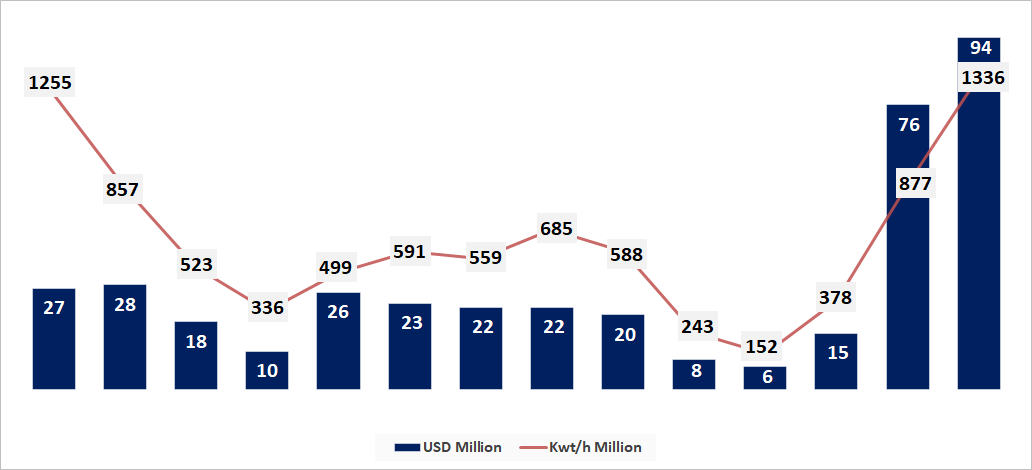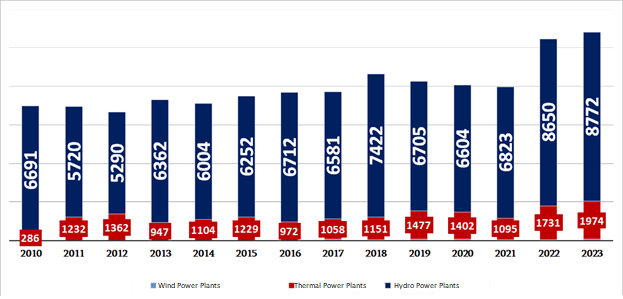Romeo Mikautadze: “This year (2023) a record amount of electricity was exported and generated.”
Verdict: FactCheck concludes that Romeo Mikautadze’s statement is HALF TRUE.
Resume: In January-August 2023, electricity export revenues exceeded USD 94 million which is higher as compared to the full 12-month figure of any previous single year. The previous USD 84 million record was registered in 2022. In terms of volume calculation, 1.336 billion kwt/h energy was exported in an eight-month period which is also a record high figure.
Similar to export, generation was also at a record high and reached 10.804 billion kwt/h in January-August.
In the past few years, none of the large HPPs or TPPs have been put into use and the increase in generation is largely because of the increased output of TPPs operating on imported natural gas and the greater energy generation by HPPs owing to favourable climate conditions. In the first eight months of 2023, generation of TPPs increased by 14%, generation of HPPs rose by 1.4% and joint energy generation from all facilities grew 3.5% in total as compared to the same period of the previous year.
This year the export growth rate was higher as compared to the growth of generation which occurred as a result of a decrease in consumption. In turn, consumption has been reduced at the expense of the occupied Abkhazia as well as large companies.
Analysis
On 10 September 2023, at an occasion dedicated to Energy Day, the First Deputy Minister of the Economy and Sustainable Development, Romeo Mikautadze, stated: “This year was important for a number of factors as we had a record-high export of electricity as well as record-high generation – their respective figures reached their historic peaks.”
Romeo Mikautadze underlined two directions in his statement – electricity export and electricity generation. The latter is always measured in kwt/h whilst export can be measured both in kwt/h or in USD if monetised.
Graph 1: Electricity Export in January-August

Source: Georgian State Electricity System and National Statistics Office of Georgia
Since electricity prices change from year to year, seasonal factors also affect the prices. Therefore, the amount and the revenue of exported electricity is not directly proportional. In January-August 2010, the average export price for 1 kwt/h was USD 0.022. It was USD 0.039 in the same period of 2015, USD 0.034 in 2018, USD 0.087 in 2022 and USD 0.07 in January-August 2023. In any case, both in terms of volume – 1.336 billion kwt/h as well as earned revenues – USD 94 million, 2023 is a record year in terms of electricity export.
According to Romeo Mikautadze’s statement, on top of export, electricity generation also reached a record high figure. In the first eight months of 2023, the country produced 10.804 billion electricity which, similar to export, is higher than the figures of every previous year.
Graph 2: Electricity Generation in January-August (Million Kwt/h)

Source: Georgia’s State Electricity System
HPPs are the main generation facilities in Georgia. Their share in production is on average 80%, although climatic conditions are also important. The same HPP produces different amounts of electricity in different years. In 2022 and 2023, not a single new or even medium-sized HPP was commissioned and the increase in generation occurred mostly due to better climatic conditions. Thermal power plants (TPPs) account for nearly 20% of the generation. In case of TPPs as well, the increase in production in 2022-2023 is related to the increase in the output load. The share of wind power plants in generation is less than 1%. There are no solar power plants whilst the share of individual panels is minimal and does not significantly affect the balance.
In the last ten years, dozens of small and several medium-sized hydroelectric power plants have been commissioned in Georgia. Of those medium-sized HPPs, we can single out the Dariali HPP, the Shuakhevi HPP and the Paravani HPP which in total generate more than one billion kwt/h of electricity annually. The large HPPs, Namakhvan, Nenskra and Khudon, remained in project form and, therefore, the country lost the opportunity to invest several billion USD, generate several billion kWh of additional electricity and the chance to bolster its own energy independence.
Usually, electricity consumption increases in parallel with economic growth and so the need for import arises if production/generation is not increased in order to offset the deficit. Georgia is able to almost fully meet its domestic demand in the field of electricity only with export import sometimes exceeding import. Normally, when generation rises, export also rises and the opposite is also true. In 2023, both of them increased, although generation rose by 3.5% and export by 23%. This kind of misbalance is explained by reduced consumption.
In January-August 2022, electricity consumption amounted to 9.567 billion kwt/h which is 8% more as compared to the same period of 2023 (8.879 billion kwt/h). Energy consumption decreased at the expense of the occupied Abkhazia and some large companies.
Under economic growth, how can companies cut consumption? In fact, only one sector reduced energy consumption; in particular, crypto miners and mining companies. In January-August 2023, BFDC (a Bitcoin farm known as BitFury) consumed 170 million kwt/h in January-August 2022 and consumed 0.6 million kwt/h in the same period of 2023 which is 280 times less. Other small mining companies and physical persons also reduced or completely halted their production in this sector as well.
This year the demand for ferro-alloys and copper ores shrank across the world, followed by a decrease in price. Under these circumstances, Georgia had to reduce its extraction/processing. As a result, the ferro-alloys plant, Chiatura-Manganese Georgia, Ruselios (producer of ferro-alloys) and Georgian Manganese consumed 963 million kwt/h in the first eight months of 2022 and their consumption dropped to 768 million kwt/h in the same period of this year.
Electricity consumption has decreased in the occupied Abkhazia as well, from 2.091 billion kwt/h to 1.827 billion kwt/h. In this region where no one pays electricity bills and the uncontrolled consumption was on the rise until very recently, the reduction was probably reduced crypto mining similar to BFCD.
Although Romeo Mikautadze provides correct facts in regard to the record generation and export, he did not name the reasons which may lead to a wrong understanding. Electricity generation has indeed increased, although it has not increased because of HPPs, TPPs, solar or wind power plants but because of purchasing additional gas for TPPs and to a certain extent better climate conditions for which the ruling party should not get a credit. In addition, export has increased and one of the reasons for this is the reduction of the production of ferro-alloys. In the first eight months of 2023, their export dropped by 20% from USD 2.480 billion to USD 1.930 billion. Among others, the export of ferro-alloys decreased by 68% from USD 365 million to USD 115 million. The revenues lost because of the decreased export of ferro-alloys is several times higher as compared to the revenues earned as a result of energy export growth and this fact cannot be put into a positive light. Given the factual accuracy and the failure to name the reasons, FactCheck concludes that Romeo Mikautadze’s statement is HALF TRUE.








